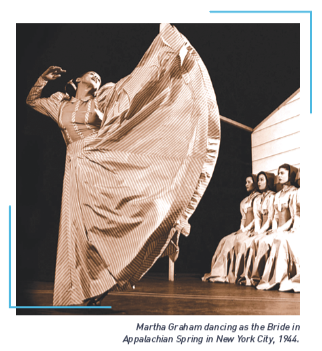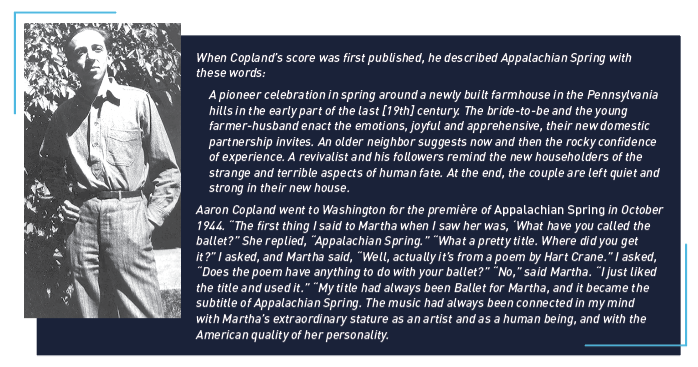 Composed 1943-4; 25 minutes
Composed 1943-4; 25 minutes
Widely regarded as one of the defining works of American music, Appalachian Spring marked a breakthrough for the 43-year-old Aaron Copland. In this 1943–44 ballet score, he tapped into wartime patriotism, a longing for simpler times, and a renewed connection to the American landscape. It sounded contemporary without alienating listeners. In earlier works such as Billy the Kid (1938), Rodeo (1942), and Lincoln Portrait (1942), Copland had already begun to bridge the gap between composers and an often-perplexed public. “I felt,” he later wrote, “that it was worth the effort to see if I couldn’t say what I had to say in the simplest possible terms.”
The idea for a collaboration began when choreographer Martha Graham turned to Thornton Wilder’s Our Town for inspiration, drawn to its affectionate portrayal of small-town American life. She began to distill her concept into a non-narrative scenario, explaining to Copland: “The ballet has to do with roots in so far as people can express them, without telling an actual story.” The setting gradually crystallized as 19th century Pennsylvania. From Graham’s notes, Copland drew the themes of “pioneer American spirit, with youth and spring, with optimism and hope.” The choreography would come later. “Finding the musical ideas to suit the feeling and the spirit comes first,” Copland explained. As the dance sequences took shape, with a broad outline of timings, he began composing what he initially titled Ballet for Martha.

The completed scenario and score depict “a pioneer celebration in spring, around a newly built farmhouse in the Pennsylvania hills, in the early part of the 19th century.” The music sounds expansive and luminous, like dawn unfolding over a quiet landscape. Copland’s harmonies linger on wide open intervals that suggest stillness and hope, while his rhythms are light and buoyant, simultaneously rooted and airborne. The score culminates in a set of variations on what was, at the time, a little-known Shaker tune, Simple Gifts, which Copland discovered in a 1940 book on Shaker music and dance. He weaves the opening notes of the tune throughout the ballet. “The music is so knit and of a completeness, that it takes you in very strong hands and leads you into its own world…Martha Graham wrote,"…and I also know that the gift to be simple will stay with people and give them great joy.”
With Appalachian Spring, Copland revealed not only a gift for simplicity, but also the confidence to leave behind the urban sophistication, jazz and blues, synagogue music, and other influences of his formative years in New York and Paris. His compositional clarity was matched by technical precision: the original score was written for just 13 instruments—the maximum that could fit in the pit of the Library of Congress auditorium, where the ballet premièred on October 30, 1944. Copland later extracted a concert suite, preserving the musical core while omitting purely choreographic passages. The work earned him the Pulitzer Prize, announced in the same issue of the New York Times as the end of World War II. His standing in American musical life was assured, and the distinctive language of Appalachian Spring, now subtitled Ballet for Martha, would soon come to define the very idea of the “American sound” in music.
— All program notes copyright © 2025 Keith Horner.
Comments welcomed: khnotes@sympatico.ca